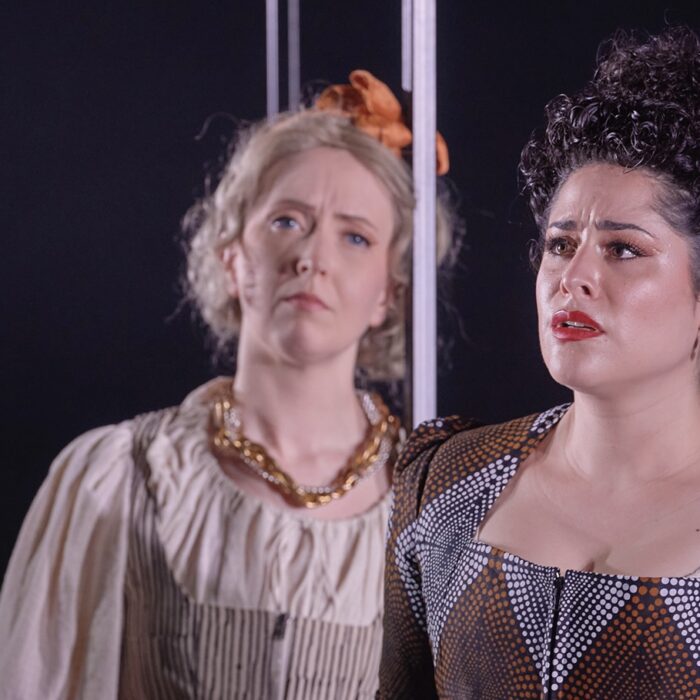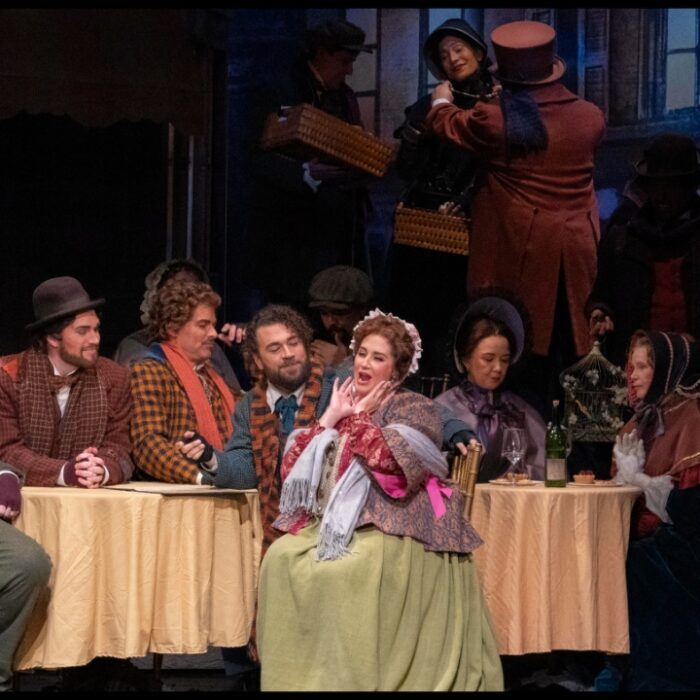
Festival d’Aix-en-Provence 2022 Review: Salome
Elsa Dreisig Stars In A Psychologically Intense Presentation
By Alan NeilsonPhoto: Bernd Uhlig
Ingo Metzmacher, the conductor for this year’s Aix-en-Provence festival’s production of Strauss’ “Salome” stressed time and again throughout his program notes the need for a cool head, for orchestral restraint and calm, for sobriety and balance. His stated aim was to ensure the orchestra does not predominate, does not get carried away, is not too loud, but is there to support the soloists.
It is not his own idiosyncratic take on the opera, but one which draws on Strauss’ own reflections, and alterations to the score for a 1930 Dresden production, which was a retouched version to accommodate the lyric soprano Maria Rajdl, whose voice required a lighter orchestral accompaniment.
A Different Musical Experience
Originally, Strauss saw his Salome as a “16 year old princess with Isolde’s voice,” a forlorn wish of course, given the power of the orchestral accompaniment, which required the penetrating voice of dramatic soprano. Over the years, however, he started to re-envisage the role, one in which the singer sounded younger, more naïve, and in which her singing could stand out more clearly. All of which, led to him recasting the role as a lyric soprano for the Dresden performance, and consequently lightening the orchestral accompaniment and changing the dynamics to reduce its overall volume. Metzmacher’s reading made use of the critical edition of Strauss, taking into account the Dresden alterations, and cast lyric soprano Elsa Dreisig in the title role. The different musical sound was substantial and noticeable, and altered the dramatic tenor of the work.
Most notably the overt eroticism of the work was reduced, the opulence, the decadence and the sultry evening heat of the Orient virtually disappeared. In other words, the opera’s lush musical atmosphere was diminished, and for those who enjoy this aspect of Strauss’ score, it was a significant loss. On the positive side, however, the dramatic side of the performance became sharper, not least owing to the fact that Salome’s words gained in clarity and rose with greater ease above the orchestral textures, rather than being subsumed within them as often happens.
The dynamic contrasts were also magnified, with the volume of the sound reduced for large periods, which was then allowed to open up for dramatic affect. Metzmacher also used the opportunity of the lighter accompaniment and reduced volumes, to bring out details of the score often lost within the dense orchestral textures, which were beautifully realised by the Orchestra de Paris.
Breth’s Sympathetic Direction
Metzmacher was supported by the stage director Andrea Breth, whose view of the work was sympathetic to the conductor’s musical vision. Both wished to present Salome as a young girl who is experiencing her first sexual desires, her awakening feelings, a teenage girl overwhelmed by her emotions. The idea of her as a “femme fatale” or a Lolita type character was absolutely rejected. To highlight this, Breth went further by ridding his reading of all the clichés associated with Salome, there were no veils, no dance, no kissing of a severed head as such. The opera turned inwards, into psychological drama, so that we watch Salome’s response, not just to her awakening desire, but also to having her love rejected in what was essentially a brutal manner, and how it, together with living in a degenerate court, destroys her mental stability.
Breth’s reading was strong and clearly presented by the singers, which he underpinned by drawing attention to the fact that all the characters when offered love, rejected it out of hand, callously, without any interest to the consequences for those who have been rejected. Narraboth’s suicide was an irrelevance to those about him, it was of absolutely no interest at all, even though he falls dead next to Salome. The connection between love and death was always central to the staging, watched over by the moon, which followed her across the stage.
In what was a particularly insightful scene, Breth presented Herod’s court dining at a long table, which deliberately imitated the last supper, for this is the end of the society, everything is rotting, and the bizarre behavior of Herodias, the querulous jews and the arguments that erupt around the table captured that sense perfectly. Significantly, it was not without resonance for our own troubled time.
Unconvincing Set Designs
Unfortunately, Raimond Orfeo Voight’s scenography along with Alexander Koppelmann’s lighting were unsuccessful at promoting Breth’s ideas, with the exception of the scene around Herod’s table, and the use of the silvery moon which was often hovering over the sets. The stage was often dark, too dark, so that on occasions, it was not even possible to identify the singers in the minor roles, even when singing. The floor of the stage frequently changed shape, breaking into pieces, which no doubt represented the fragmenting psychological states of the characters, but with a fine net curtain across the stage, it was sometimes difficult to make out exactly what was happening. Towards the end of the final scene, Salome was positioned alone in a small, sordid, white-tiled room, musing on kissing Jochanaan’s severed head, which she carried around in a white plastic bowl. The ideas behind the designs were clear enough, but they were ugly, brutal, crude and failed to engage.
Alexandra Charles’ costumes had a fairly neutral impact. They were unobtrusive, but could not overcome the heavy darkness that prevailed.
Salome’s Dance of the Seven Veils was replaced by multiple Salome’s wandering and writhing across the stage in various states of mental distress and anxiety. It bore little connection to the music, and although it fitted with Metzmacher and Breth’s overall conception of the work it did not convince.
Dreisig’s Stamps Her Mark On The Role
Metzmacher may well have demanded restraint from the orchestra, but not so from his Salome Elsa Dreisig, whom he expected to take risks in bringing Salome alive, and she did not disappoint. In what was a first class performance she proved herself not just a first class singer, but also an exceptionally fine actress. From the outset, her Salome was mentally fragile, and as her obsession with Jochanaan grew, so too her behavior became increasingly volatile as she focused more upon herself, looking inwards and withdrawing from the world around her. Every gesture and facial expression was carefully managed to express her psychological decline. That there was no dance of the seven veils accentuated her distance, that would have only acted as a connection to the world. Her ravings in her final scene appeared as a natural continuation of her mental unravelling.
Although the orchestral accompaniment was lighter to accommodate Dreisig’s voice, the part still required vocal strength, stamina, volume and power, which she provided with apparent ease, while moulding her phrases intelligently to capture Salome’s volatile personality, which was wonderfully displayed in the monologue “Ah! Du wollest mich nicht deinen Mund küssen lassen” as she coated the voice in array of changing emotions. Yet, her focus on character did not prevent Dresig from also revealing the splendour of Staruss’ music, as she delivered long sensuous lines, beautifully fashioned and securely delivered.
Strong Singing Throughout
Tenor John Daszak created a convincing portrait of an aggressive, unhinged Herod who, self-indulgent and unstable, oversaw a court created in his own image. His erratic behavior, along with his dark suit often gave the impression of him as a gangster-like figure, he was thoroughly dislikable! He sang with conviction, infusing his voice with menace and aggression, frenzy and dread. In the scene in which he pleads with Salome to take something other than Jochanaan’s head, Daszak superbly captured his character’s cowardice, hypocrisy and decadence.
Could there be a better Herodias than Angela Denoke? On the basis of this performance, I seriously doubt it. Her singing was strong and meaningful, and her acting was brilliantly crafted to catch every idiosyncratic nuance, so that she came across as completely crazy, yet also manipulative and vicious.
Bass-baritone Gábor Bretz was a suitably authoritative Jochanaan, whose voice had the necessary substance and conviction. Why Voight had his head placed on the table during “the last supper” was baffling in the extreme; when he sang it had the appearance of a comedy sketch. It undermined the whole scene.
Tenor Joel Prieto was a sympathetic Narraboth. He produced an expressive singing performance, capturing his character’s sincere feelings for Salome. Clearly attentive to Salome’s every need and her wellbeing, the disinterest with which everyone treated his suicide was chilling.
The five jews played by the tenors Léo Vermot-Desroches, Kristofer Lundin, Rodolphe Briand, Grégoire Mour and bass Sulkan Jaiani were excellent. When they entered into discussions with each other, the energy and fervour they brought to their singing, briefly energised a different dimension to the narrative.
The small role of Herodias’ Page was played by the mezzo-soprano Carolyn Sproule. She made full use of the opportunity with a confident performance that showed off the pleasing quality of her voice.
Overall, this was an interesting performance, in which the conductor and director combined successfully to create a psychologically strong picture of Salome, Herod and his court, one which side-stepped the usual highlights of a production, but which stayed true to the underlying narrative.
However, it was Metzmacher’s decision to use a score with a lighter orchestral accompaniment that is likely provoke most discussion. Personally, I love the lush, sensual and oriental extravagance of the original, and is not something I would not want to lose.



